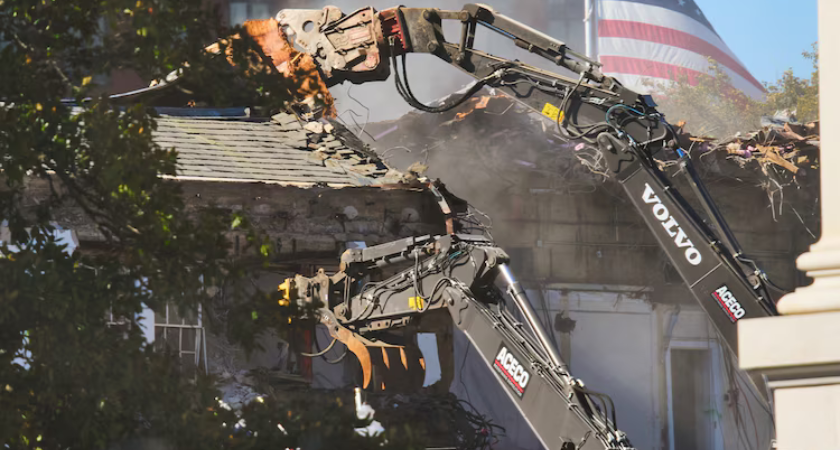
WASHINGTON, D.C. — The White House East Wing is expected to be demolished as early as this weekend to make room for President Donald Trump’s proposed $300 million ballroom, according to sources familiar with the project who spoke to ABC News. The development marks a far more extensive renovation than the president had previously disclosed.

Construction activity intensified this week, with multiple trucks and crews seen entering and exiting the secured work zone. A seven-foot privacy fence now surrounds the site, obscuring much of the demolition from public view.
The New York Times first reported the plans, which have since been confirmed by several administration sources. The White House has yet to issue a detailed statement on the demolition timeline, though one official told ABC News that “the entirety of the East Wing will be modernized.”
“We determined that after really a tremendous amount of study with some of the best architects in the world, we determined that really knocking it down, trying to use a little section, you know, the East Wing was not much. It was not much left from the original,” President Trump said during an Oval Office event on Wednesday. “In order to do it properly, we had to take down the existing structure.”
The president’s comments contrast with his earlier assurances made in July, when he said the ballroom “would not interfere” with the existing East Wing and would be “near it but not touching it.” The new revelation underscores how dramatically the project has evolved in recent months.
While the ballroom plans have not yet been submitted to the National Capital Planning Commission (NCPC)—a required step for major federal construction projects—demolition is already underway. A White House official said submission of the plans is still forthcoming.
During the same press availability, Trump displayed architectural renderings of the ballroom while discussing unrelated foreign policy topics. When asked about transparency, he bristled at the suggestion that he had kept the project under wraps.
“I haven’t been transparent? Really? I’ve shown — I’ve shown this to everybody that would listen,” Trump said.
The ballroom project, reportedly modeled after the grand hall at Trump’s Mar-a-Lago estate in Florida, will span approximately 90,000 square feet. The president has said it will be funded “personally and by donors,” though the administration has provided no list of contributors, raising questions about ethics and oversight.
The White House Historical Association confirmed it has completed digital scanning and preservation of the East Wing before demolition.
“The East Wing and gardens have been captured in detail for the benefit of our nation and historic artifacts from the East Wing have been preserved and stored,” the association said in a statement.
A White House official added that “all the historical components of the East Wing … have been preserved and stored under the supervision of the White House Executive Residence and the National Park Service with support from the White House Historical Association.”
The Office of the First Lady and other East Wing staff have been relocated to other buildings on the White House campus, including the Eisenhower Executive Office Building, more than a month ahead of the demolition.
Reaction to the project has been swift and divided. Former First Lady Hillary Clinton criticized the move in a post on X, writing:
“It’s not his house. It’s your house. And he’s destroying it.”
The National Trust for Historic Preservation also raised alarm, sending a letter to Will Scharf, the White House staff secretary and NCPC chair, urging a pause until the project undergoes public review.
“While the National Trust acknowledges the utility of a larger meeting space at the White House, we are deeply concerned that the massing and height of the proposed new construction will overwhelm the White House itself,” wrote Dr. Carol Quillen, president of the Trust.
The nonprofit called for full review by both the NCPC and the Commission of Fine Arts, noting that any alteration to the White House’s classical balance could have lasting architectural consequences.

The administration defended the project in a lengthy press release, describing it as “a bold, necessary addition that echoes the storied history of improvements and additions from commanders-in-chief to keep the executive residence as a beacon of American excellence.”
White House Press Secretary Karoline Leavitt dismissed criticism as “fake outrage,” comparing Trump’s renovation to previous presidential projects, such as Truman’s 1948 reconstruction and Obama’s 2015 modernization of the Situation Room.
“He is the builder-in-chief,” Leavitt said on Fox News’ Jesse Watters Primetime. “He was elected back to this People’s House because he is good at building things. At the end, the East Wing … will be more modern and beautiful than ever. And then on top of that, the White House is going to have a big, beautiful ballroom for generations of Americans to come.”
According to the Wall Street Journal, the neighboring Treasury Department has instructed its employees not to share photos of the ongoing demolition.
Still, the president appeared upbeat about the work. Hosting Senate Republicans for lunch at the newly renovated Rose Garden Club, Trump said,
“You probably hear the beautiful sound of construction in the back. You hear that? Oh, that’s music to my ears. I love that sound. Other people don’t like it; I love it.”
The ballroom project is one of the most ambitious White House alterations since the Truman Reconstruction (1948–1952) and comes amid a federal government shutdown now in its fourth week. Despite furloughs across agencies, national security and executive residence projects are exempted from shutdown halts, allowing construction to continue.
As demolition proceeds, questions remain about funding transparency, historic preservation, and long-term architectural impact. For now, the East Wing’s iconic façade—home for decades to first ladies and staff—stands partially dismantled, awaiting the transformation of one of the world’s most recognized residences.
Originally reported by Karen Travers, Rachel Scott, Katherine Faulders, and Hannah Demissie in ABC News.